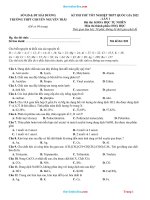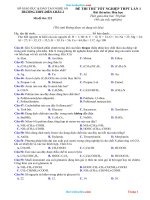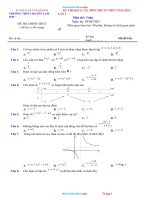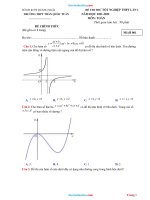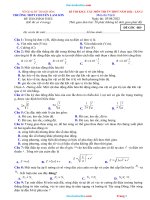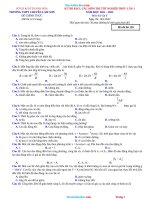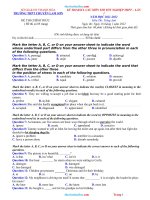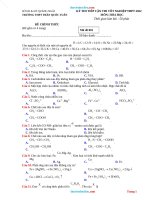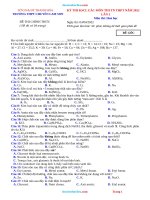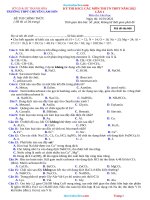Đề thi ks tn (2022 2023)
Bạn đang xem bản rút gọn của tài liệu. Xem và tải ngay bản đầy đủ của tài liệu tại đây (233.45 KB, 13 trang )
SỞ GD&ĐT THANH HĨA
TRƯỜNG THPT .
Mã đề:101
Họ và tên thí sinh:………………
ĐÈ KSCL CÁC MƠN THI TỐT NGHIỆPNĂM HỌC: 2022- 2023
Mơn: TIẾNG ANH.
Thời gian: 60 phút. (Không kể thời gian giao đề)
Số báo danh……………………
Mark the letter A, B, C, or D on your answer sheet to indicate the word whose underlined part differs from
the other three in pronunciation in each of the following questions.
Question 1: A. marched
B. leaked
C. acted
D. leaped
Question 2: A. life
B. light
C. size
D. twin
Mark the letter A, B, C, or D on your answer sheet to indicate the word that differs from the other three in
the position of the primary stress in each of the following questions.
Question 3: A. evolve
B. protect
C. teacher
D. resist
Question 4: A. industry
B. reflection
C. division
D. remember
Mark the letter A, B, C, or D on your answer sheet to indicate the correct answer to each of the following
questions.
Question 5: Danny has never been to Viet Nam, ______?
A.was he
B. has he
C. didn't he
D. hasn’t he
Question 6: This house________ in 2000 by my parents.
A. build
B. was building
C. was built
D. has built
Question 7: It's time you were independent ______ your parents and did what you wanted.
A. of
B. with
C. on
D. to
Question 8: The more tired you are, ______ it is to concentrate.
A. the hardest
B. hard
C. hardest
D. the harder
Question 9: When I was going to school this morning, I saw a _______ girl. She asked me how to get to Hoan
Kiem Lake
A. beautiful young blonde Russian
B. beautiful young Russian blonde
C. blonde young beautiful Russian
D. Russian young blonde beautiful
Question 10: Lisa ______ to school when she saw the accident.
A. was cycling
B. cycles
C. is cycling
D. has cycled
Question 11: ______ applying for hundreds of jobs, he is still out of work.
A. Because
B. Because of
C. Despite
D. Although
Question 12: ______, I will finish the report.
A. As soon as I get to work
B. As soon as I got to work
C. As soon as I had got to work
D. As soon as I was getting to work
Question 13: ______ the stories about people who reduced their carbon footprint, we started to change our daily
consumption habits.
A. Read
B. Having read
C. To read
D. Being read
Question 14: The principal of our school is a highly _______ person.
A. respect
B. respecting
C. respectable
D. respectively
Question 15: I cannot believe Peter and Mary______ last week. They have been married for almost fifteen years. I
hope they get back together.
A. went up
B. gave up
C. looked down
D. broke up
Question 16: My sister takes ______ for sweeping the house.
A. responsibility
B. ability
C. possibility
D.probability
Question 17: He wasn't aware that only one mistake could________his chances of getting the job.
A. destroy
B. ruin
C. damage
D. devastate
Question 18: He was off school for a while and is finding it hard to _____ with his classmates.
A. went through
B. catch up
C. get on
D. put up
Question 19: In the formal interview, it is essential to maintain good eye ________with the interviewers.
A. contact
B. touch
C. link
D. connection
Mark the letter A, B, C, or D on your answer sheet to indicate the word CLOSEST in meaning to the underlined
word in each of the following questions.
Question 20: It is a well-known fact that caffeine is a stimulant. So, don’t drink too much.
A. horrible
B. relaxing
C. famous
D. comfortable
Question 21: School uniform is compulsory in most of Vietnamese schools.
A. paid
B. divided
C. depended
D. required
Mark the letter A, B, C, or D on your answer sheet to indicate the word(s) OPPOSITE in meaning to the
underlined word(s) in each of the following questions.
Question 22: It's not beyond the realm of possibility that some schools may have to cut sport altogether.
A. possible
B. impossible
C. unlikely
D. certain
Question 23: In Western culture, it is polite to maintain eye contact during conversation.
A. informal
B.discourteous
C. insecure
D. irresponsible
Mark the letter A, B, C, or D on your answer sheet to indicate the option that best completes each of the fol lowing exchanges.
Question 24: Linda and Daniel are discussing life in the future.
Linda: “I believe space travel will become more affordable for many people in the future.”
Daniel: “______”
A. There’s no doubt about that.
B. It doesn’t matter at all.
C. I am sorry to hear that.
D. It is very kind of you to say so.
Question 25: Mary and John are having dinner.
Mary: “Would you like some more chicken?” John: “_______ I’m full.”
A. Yes, please
B. No, thanks
C. Yes, I would
D. No, I wouldn’t
Read the following passage and mark the letter A, B, C or D on your answer sheet to indicate the correct word
or phrase that best fits each of the numbered blanks from 26 to 30.
Mobile phones: a benefit or social nuisance?
Few people under 30 will be able to imagine a time before the existence of mobile phones. Neither will
they be (26)_________of the harmful effect that many people predicted text language would have on young
people’s language skills.
Interestingly, linguists nowadays believe that expressing oneself clearly in texts is evidence of a good
background in grammar and sentence structure. Mobile phones are credited with encouraging people to
communicate more. They can also provide reassurance to people (27)_____are alone in dangerous situations. Some
people use mobile phones as a kind of barrier to unwelcome social contact; texting can signal your unavailability to
(28)______people in the same way that wearing sunglasses and headphones does.
Some issues with mobile phones are still controversial. Talking loudly on the phone while on public
transport is thought to be rude and (29)_____by many people in the UK. (30)______, a significant minority of
people still do it, despite the sighing and other obvious signs of disapproval from their fellow passengers.
(Adapted from “AdvancedExpert’’ by Jan Bell and Roger Gower)
Question 26: A. anxious
B. alert
C. aware
D. forgetful
Question 27: A. which
B. when
C. where
D. who
Question 28: A. other
B. another
C. every
D. one
Question 29: A. inconsiderate
B. insignificant
C. inflexible
D. inattentive
Question 30: A. Therefore
B. However
C. Moreover
D. Otherwise
Read the following passage and mark the letter A, B, C, or D on your answer sheet to indicate the correct
answer to each of the questions from 31 to 35.
The sound of music has changed as society has changed over the years, thus the change in the sound of
music is really a reflection of our cultural evolution. In the beginning humans made music that closely mimicked
the sounds they heard around them in nature in terms of tones and repetitions.
In Indigenous cultures, music played a role in ceremonies and traditions. Traditional instruments were
played, and lyrics were often strongly linked to nature. The sounds of music reflected this close association that
indigenous cultures had with the land and its wildlife. Over time, modern society has lost this connection. This is
reflected in the changing sound of the music and in the changing lyrics of songs that are sung. With time, more
musical instruments were developed and played together, which resulted in more sophisticated and complex
sounds being produced. The beats, rhythms, tempo and lyrics of songs all changed along with the change in
cultures.
Although some indigenous cultures such as many of the African tribes, Native American tribes, South
American ethnic people, and Australian aborigines still retain the playing of their indigenous music, there have
been influences from the western world incorporated into some of the music. Features of the sound of music have
changed over the decades. The sound has definitely gotten louder. The pace and rhythm in many cases have
become faster, possibly reflecting the fast pace of the modern world that we live in today. However the feature of
music bounciness (how spiky and energetic the music feels) has become less today when compared with the music
of the1980s. Techno and reggae music are typical examples of what is known as bouncy music.
The sound of music has become more complex over history mainly due to the increased migration of
people and their exposure to new elements. Today much of music has sounds with elements from more than one
region. The increasing tendency for music artists to collaborate today is another reason we see more complexity
and diversity in how music sounds.
(Adapted from />Question 31: Which of the following could serve as the best title for the passage?
A. Why People Changed the Sound of Music?
B. Music: Now and Then
C. The Role of Music in Indigenous Cultures
D. Nature and Music
Question 32: The word “which” in paragraph 2 refers to __________.
A. musical instruments
B. developing and playing many musical instruments together
C. the changing sound of the music
D. the changing lyrics of songs
Question 33: The word “retain” in paragraph 3 could be best replaced by __________.
A. preserve
B. reduce
C. exchange
D. combine
Question 34: According to the passage, the following features of music have increased over years, EXCEPT
__________.
A. the sound volume
B. the pace and rhythm
C. the connection to nature
D. the sound’s complexity and diversity
Question 35: Which of the following is TRUE?
A. Western music has more influence on indigenous music than others.
B. The fast pace of life has caused the loss of connection to nature.
C. Almost every feature of music sounds changed when the cultures altered.
D. Modern music sounds contain different regional elements due to the collaboration of music artists
Read the following passage and mark the letter A, B, C, or D on your answer sheet to indicate the correct
answer to each of the questions from 36-42
From smartphones and tablets to apps and social media, society is ambushed from all sides with technology.
Naturally, all generations embrace it differently, with younger “digital natives” generally being more connected,
more switched-on and more tech literate than older age groups.
According to Pew Research, 92% of Millennials (born 1981–1996) own smartphones, compared with 85% of
Gen Xers (born 1965–1980) and 67% of Baby Boomers (born 1946–1964). In terms of tech behavior, older
generations tend to use their phones mostly for making calls, whereas for younger generations, a phone is their
digital window to the world. Phones are used for social media, going online, texting, emailing, playing games,
listening to music, and recording and watching videos.
The daily media consumption of different generations also vastly differs. Gen Z and Millennials favor
streaming and online services, with 46% of teens saying they use Netflix compared to 31% of those aged over 16.
Furthermore, 16-24s spend 30% of their downtime watching TV or video, compared to 40% of time spent on these
activities by the average UK adult. Boomers spend a whopping 344 minutes a day watching regular TV,
significantly more than any other age group.
Size also matters more depending on your decade of birth. Younger generations prefer smaller screens sizes,
opting for a smartphone as their go-to tech, while Generation X and technology newbies - the Boomers, are going
bigger, owning more desktops and tablets. Always in the front of the queue for the hottest tech, younger
generations see technology as an integral part of their existence, and since few Millennials and Gen Z can
remember a time without social media, they’re more fearless and carefree when it comes to technology. So much
so, that a LivePerson report revealed 65% of Millennials and Gen Z interact more with each other online than they
do in the real world.
Fundamentally, these behaviors and preferred technologies combine to create a technological generation gap,
where employees, shaped by their personal experiences, demonstrate different levels of ability and willingness to
adopt new tech. Constantly chasing the next update or device, switched on Millennials and Gen Z are quick to lap
up the latest apps, games, and platforms, while Gen X and Boomers are generally slower to embrace technology both at home and in the workplace.
(Source: />Question 36: Which best serves as the title for the passage?
A. Bridging the technological generation gap.
B. Decoding the ethical generational gap.
C. The technological generation gap in family life. D. What is the technological generation gap?
Question 37: The word “it” in paragraph 1 refers to _____.
A. window
B. media
C. society
D. technology
Question 38: According to paragraph 2, what is the technological characteristic of Millennials?
A. They are hesitant when discussing about technology.
B. They are dependent on smartphones for almost every activity.
C. They are optimistic about technology’s benefits to society.
D. They are ignorant to the older ones’ advice about technology.
Question 39: The word “downtime” in paragraph 3 is closest in meaning to _______.
A. spare time
B. inactivity
C. suspension
D. stay
Question 40: According to paragraph 4, which statement is correct about different generations and their gap?
A. Boomers are willing to queue overnight for a state-of-the-art mobile gadgets.
B. Millennials and Gen Z are more accustomed to face-to-face than messaging.
C. iPhones and other mobile devices are a necessary part of life by young people.
D. Younger generations prefer bigger technological devices over portable ones.
Question 41: The word “embrace” in paragraph 5 is closest in meaning to _______.
A. reject
B. include
C. cuddle
D. adopt
Question 42: Which of the following statements is TRUE, according to the passage?
A. Younger people always know more about technology than the older generation does.
B. Digital savviness decrease with age is a major misunderstanding caused by media.
C. The generation users are born into affects their choices for size of technological gadgets.
D. Netflix is among the streaming services preferred by the Millennial generation.
Mark the letter A, B, C, or D on your answer sheet to indicate the underlined part that needs correction in
each of the following questions.
Question 43: Yesterday morning, Minh arrives late for school for the first time
A. morning
B. first
C. school
D. arrives
Question 44: The disabled were believed to be not able to physically take care of herself, but it was totally wrong.
A. herself
B. believed
C. physically
D. disabled
Question 45: : Public speaking is quite a frightening experience for many people as it can produce a status of mind
similar to panic.
A. quite
B.frightening
C. status
D.panic
Mark the letter A, B, C, or D to indicate the sentence that is closest in meaning to each of the questions.
Question 46:I haven't met my grandparents for five years.
A. I last met my grandparents five years ago.
B. I often met my grandparents five years ago.
CI have met my grandparents for five years.
D. I didn't meet my grandparents five years ago.
Question 47: “Would you like to come out to dinner with me tonight, Jenny?” Paul said.
A. Paul suggested that Jenny go out to dinner with him that night.
B. Paul insisted on Jenny going out to dinner with him that night.
C. Pau offered Jenny to go out to dinner with him that night
D. Paul invited Jenny to go out to dinner with him that night
Question 48: It is not necessary for you to type all these documents.
A. You mightn't type all these documents.
B. You needn't type all these documents.
C. You shouldn't type all these documents.
D. You mustn't type all these documents.
Mark the letter A, B, C, or D to indicate the sentence that best combines each pair of sentences in the following
questions.
Question 49: Susan didn’t apply for the summer job in the café. She now regrets it.
A. Susan feels regret because she didn’t apply for the summer job in the café.
B. If only Susan didn’t apply for the summer job in the café.
C. Susan wishes that she had applied for the summer job in the café.
D. If only Susan hadn’t apply for the summer job in the café.
Question 50: You can feel more at ease by taking part in group dating. It’s the only way.
A. By taking part in group dating can you only feel more at ease.
B. Only by taking part in group dating can you feel more at ease.
C. The only way you are by taking part in group dating can feel more at ease.
D. The way you can feel more at ease is taking part in only group dating.
SỞ GD&ĐT THANH HÓA
TRƯỜNG THPTQUẢNG XƯƠNG4
I. ĐÁP ÁN
Mã đề 001
Câu
Đáp án
1
C
2
D
3
C
4
A
5
B
6
C
7
A
8
D
9
A
10
A
11
C
12
A
13
B
14
C
15
D
16
A
17
B
18
B
19
A
20
C
21
D
22
A
23
B
24
A
25
B
26
C
27
D
28
A
29
A
30
B
31
B
32
B
33
A
34
C
35
C
36
D
37
D
38
B
39
A
40
C
41
D
42
C
43
D
44
A
45
C
46
A
47
D
48
B
49
C
ĐÁP ÁN ĐỀ THI KHẢO SÁT CHẤT LƯỢNG TN THPT
LẦN 1 - NĂM HỌC 2022-2023
Môn thi: Tiếng anh
Khối: 12
Mã đề 002
Câu
Đáp án
1
2
3
4
5
6
7
8
9
10
11
12
13
14
15
16
17
18
19
20
21
22
23
24
25
26
27
28
29
30
31
32
33
34
35
36
37
38
39
40
41
42
43
44
45
46
47
48
49
Mã đề 003
Câu
Đáp án
1
2
3
4
5
6
7
8
9
10
11
12
13
14
15
16
17
18
19
20
21
22
23
24
25
26
27
28
29
30
31
32
33
34
35
36
37
38
39
40
41
42
43
44
45
46
47
48
49
Mã đề 004
Câu
Đáp án
1
2
3
4
5
6
7
8
9
10
11
12
13
14
15
16
17
18
19
20
21
22
23
24
25
26
27
28
29
30
31
32
33
34
35
36
37
38
39
40
41
42
43
44
45
46
47
48
49
50
B
50
50
50
Đáp án chi tiết Mã 101
Mark the letter A, B, C, or D on your answer sheet to indicate the word whose underlined part differs from the
other three in pronunciation in each of the following questions.
Question 1. A. marched
B. leaked
C. acted
D. leaped
Nhận biết đuôi ED (t,d +ed->id),ch,p k+ed-vậy đáp án là C
Question 2. A. life
B. light
C. size
D.twin
Phát âm nguyên âm/ i/
Nguyên âm I trong lựa chọn :A,B,C phát âm/ai/ , đáp án là D phát âm /I/
Question 3: Đáp án C
Kiến thức về trọng âm
=> Đáp án C có trọng âm rơi vào âm tiết thứ nhất. Các đáp án cịn lại có trọng âm rơi vào âm tiết thứ
hai.
Question 4: Đáp án A
Kiến thức về trọng âm
B. reflection từ này có trọng âm rơi vào âm tiết thứ hai –đi tion
C. division
từ này có trọng âm rơi vào âm tiết thứ hai-đuổi-sion
A. industry /: từ này có trọng âm rơi vào âm tiết thứ nhất. noun có đi y trịng âm đánh vào âm tiết thứ 3
từ đi lên
D. remember từ này có trọng âm rơi vào âm tiết thứ hai
=> Đáp án A có trọng âm rơi vào âm tiết thứ nhất. Các đáp án cịn lại có trọng âm rơi vào âm tiết thứ hai.
Mark the letter A, B, C, or D on your answer sheet to indicate the correct answer to each of the following questions.
Question 5: Danny has never been to Viet Nam, ______?
A.was he
B. has he
C. didn't he
D. hasn’t he
Giải thích:Câu hỏi đi:
Mệnh đề chính phủ định → câu hỏi đi khẳng định
Mệnh đề chính dùng thì hiện tại hồn thành→ câu hỏi đi dùng “has he”
Tạm dịch: Danny chưa bao giờ đến Pháp, có đúng khơng?
Đáp án B.
Question 6: This house________ in 2000 by my parents.
A. build
B. was building
C. was built
D. has built
Bị động của thì quá khứ đơn Đáp án C
Question 7. Đáp án: A
It's time you were independent ______ your parents and did what you wanted.
A. of
B. with
C. on
D. to
Giới từ: independent of
Question 8: The more tired you are, ______ it is to concentrate.
A. the hardest
B. hard
C. hardest
D. the harder
Giải chi tiết:
Cơng thức so sánh kép: The + more + tính từ dài + S + tobe, the + adj_ngắn + _er + S + tobe …: …càng…càng…
tired => more tired, hard => harder
Tạm dịch: Thật khó để tập trung khi bạn mệt mỏi. (vẫn có thể tập trung nhưng khơng dễ dàng)
= Bạn càng mệt mỏi, càng khó tập trung.
Các phương án khác:
A. Sự mệt mỏi của bạn khiến bạn không thể tập trung. => sai nghĩa
B. Bạn không thể tập trung do mệt mỏi. => sai nghĩa
C. Sự mệt mỏi của bạn dẫn đến việc bạn khơng có khả năng tập trung. => sai nghĩa
Chọn D.
Question 9:Đáp án A
Kiến thức : Trật tự tính tính
Giải thích:
Ta có cách sắp xếp tính từ. OSASCOMP + N
O - opinion: ý kiếnS- size: kích cỡA - Age: tuổiS - shape: hình dángC –
colour: màu sắcO - origin: nguồn gốcM - material: chất liệuP -purpose: mục đích
→ beautiful – Opinion young - Age
blonde – Color
Russian → Origin
Tạm dịch: Khi tơi đi học sáng nay, tơi nhìn thấy một cơ gái Nga trẻ đẹp tóc vàng. Cơ ấy hỏi tơi làm thế nào để đến Hồ
Hồn Kiếm
Question 10: Đáp án A
Lisa ______ to school when she saw the accident.
A. was cycling B. cycles
C. is cycling
D. has cycled
Kết hợp thì : Qúa khứ tiếp diễn và When + quá khứ đơn
Question 11: ______ applying for hundreds of jobs, he is still out of work.
A. Because
B. Because of
C. Despite
D. Although
Kiến thức về liên từ
Tạm dịch: Mặc dù anh ta đã nộp đơn cho hàng trăm vị trí, anh ta vẫn bị thất nghiệp.
Xét các đáp án:
C. Although /ɔːlˈðəʊ/: mặc dù (+ clause)B. In spite of: mặc dù (+ N/V-ing)
A. Because /bɪˈkəz/: bởi vì (+ clause) D. Because of: bởi vì, là do (+ N/V-ing)
Cấu trúc khác cần lưu ý:
Apply for sth: nộp đơn ứng tuyển vào vị trí gì
Out of work: bị thất nghiệp, khơng có việc làm
Đáp án C.
Question 12: ______, I will finish the report.
A. As soon as I get to work
B. As soon as I got to work
C. As soon as I had got to work
D. As soon as I was getting to work
kiến thức mệnh đề trạng ngữ chỉ thời gian
Đáp án : A
Question 13: ______ the stories about people who reduced their carbon footprint, we started to change our daily
consumption habits.
A. Read
B. Having read
C. To read
D. Being read
Đáp án: Giải thích: Kiến thức rút gọn mệnh đề trạng ngữ: khi hai vế có cùng chủ ngữ, ta có thể lược bỏ chủ ngữ và
động từ chuyển sang dạng Ving.
Đáp án B
Question 14: : The principal of our school is a highly _______ person.
A. respect
B. respecting
C. respectable
D. respectively
Đáp án C –respectable(adj)
(Hiệu trưởng của trường chúng tơi là một người đáng ________.)
Giải thích: Xét về nghĩa từ 'respect' phù hợp. Chỗ trống cần điền tính từ nên 'respect' được chuyển thành 'respectable'
Question 15. I cannot believe Peter and Mary______ last week. They have been married for almost fifteen years. I hope
they get back together.
A. went up
B. gave up
C. looked down
D. broke up
Đáp án D- Hướng dẫn giải
Phương pháp giải: Kiến thức: Cụm động từ
Giải thích: break up: chia tay, ly hôn
Tạm dịch: Tôi không thể tin được rằng Peter và Mary đã ly hôn tuần trước. Họ đã kết hôn được gần mười lăm năm rồi.
Hy vọng họ sẽ quay trở lại với nhau.
Question 16: Word choice Từ vựngcùng trường nghĩa
Đáp án :A
My sister takes ______ for sweeping the house.
A. responsibility
B. ability
C. possibility
D.probability
take reasponsibility for smt: chịu trách nhiệm, đảm nhiệm về cái gì.
Các đáp án cịn lại:
A. possibility (n): có khả năng.C. probability (n): có khả năng.D. ability (n): có năng lực.
Question17 Kiến thức về từ vựng/ động từ cùng trường nghĩa Đáp án B
A. destroy (v): phá hủy, tàn phá (làm cho hư hại, phá hồn tồn đến khơng cịn dùng đuợc nữa)
B. ruin /ru in/ (v): làm hỏng, phá hủy giá tri, cơ hội, thủ vui, quang cành); làm mất thanh danh, tiền tài, dịa vị
C. damage / dỉm.id3/ (v): làm hư hịng, hủy hoai, phá hủy cái gì
D. devastate / devestert (v): phá hủy cái gì hay một nơi nào đó một cách hoàn toàn; gây thiệt hại lớn; khiến ai
cầm thấy buồn, sốc, thất vọng.
Tạm dịch: Anh ấy đã không nhận thức được rằng chỉ một chút sai lầm có thể phá hịng cơ hội nhận được cơng
việc.
Question 18:Cum động từ Đáp án B. catch up with SB theo kip ai phù hợp nghĩa của câu
He was off school for a while and is finding it hard to _____ with his classmates.
A. went through with
C. get on with: hòa thuận với ai
D. put up with chịu đựng
Question 19: Kiến thức: cum từ
Đáp án A
Xem xét nghĩa các đáp án ta có
A. contact: liên lạc/ sự giao tiếp/ tương tác
B. touch: đụng chạm
C. link: liên kết
D. connection: sự liên kết
Vì phía trước chỗ trống ta có danh từ “eye” nên có đáp án phù hợp là “eye contact” (sự giao tiếp bằng mắt)
Dịch: Trong cuộc phỏng vấn chính thức, rất quan trọng để duy trì sự giao tiếp bằng mắt với người phỏng vấn
Mark the letter A, B, C, or D on your answer sheet to indicate the word CLOSEST in meaning to the underlined
word in each of the following questions.
Question 20: Kiến thức từ đồng nghĩa
Đáp án C : well-known = famous : nổi tiếng
A. horrible( kinh khủng)
B. relaxing( thư giản ,dể chịu) D. comfortable ( thoải mái)
Question 21: Kiến thức từ đồng nghĩa
Giải thích:
A. paid (adj): được trả tiền
B. divided (adj): bị phân chia, chia rẽ
D. required (adj): cần thiết, được yêu cầu
C. depended (v-ed): phụ thuộc
Compulsory (adj): có tính bắt buộc = required
Tạm dịch: Đồng phục trường học là bắt buộc ở đa số các trường học ở Việt Nam.
→ Chọn đáp án D
Mark the letter A, B, C, or D on your answer sheet to indicate the word(s) OPPOSITE in meaning to the
underlined word(s) in each of the following questions
Question 22: Kiến thức : từ trái nghĩa(cụm từ)
Đáp án A
- beyond the realm of possibility: bất khả thi/ khơng có khả năng
A. possible (a): có thể/ có khả năng
B. impossible (a): khơng có thể/ khơng có khả năng
C. unlikely (a): khơng chắc chắn xảy ra
D. certain (a): chắc chắn
beyond the realm of possibility >< possible
Tạm dịch: Khơng phải là khơng có khả năng một số trường cắt hoàn toàn thể thao.
Question 23: In Western culture, it is polite to maintain eye contact during conversation.
A. insecure
B. discourteous
C. informal
D. irresponsible
Đáp án B :vì polite ( lịch sự) >< discourteous ( bất lịch sự ,khiếm nhã)
Mark the letter A, B, C, or D on your answer sheet to indicate the option that best completes each of the following
exchanges.
Question 24. Linda and Daniel are discussing life in the future.
Linda: “I believe space travel will become more affordable for many people in the future.”
Daniel: “______”
A. There’s no doubt about that.
B. It doesn’t matter at all.
C. I am sorry to hear that.
D. It is very kind of you to say so
Đáp án A.
Paul và Daisy đang thảo luận về cuộc sống trong tương lai.
Paul: “Tớ tin rằng giá dịch vụ du lịch ngoài vũ trụ sẽ trở nên phải chăng hơn đối với nhiều người trong
tương lai.”
-Daisy: “Tớ hoàn toàn đồng ý”
Chú ý: There’s no doubt about that: Khơng cịn nghi ngờ gì nữa = I totally agreed: Tơi hồn tồn đồng ý.
Các đáp án cịn lại khơng phù hợp:
A. Chả có vấn đề gì cả.
C. Cậu thật tốt khi nói vậy.
D. Tớ rất tiếc khi nghe được điều đó.
Question 25: Đáp án đúng: B
Mary and John are having dinner.
Mary: “Would you like some more chicken?” John: “_______ I’m full.”
A. Yes, please
B. No, thanks
C. Yes, I would
D. No, I wouldn’t
Đáp án đúng: B
Dịch: - "Bạn có muốn thêm một ít thịt gà không?"- "Không, cám ơn. Tôi no rồi ”.
Read the following passage and mark the letter A, B, C or D on your answer sheet to indicate the correct word or
phrase that best fits each of the numbered blanks from 26 to 30.
Question 26(TH). Đáp án C Kiến thức: Từ vựng
A. anxious + about (adj): lo âu, lo lắng, băn khoăn
B. alert + to (adj): tỉnh táo, cảnh giác
C. aware + of (adj): nhận thức, nhận biết
D. forgetful (adj): hay quên, có trí nhớ kém
Neither will they be (26) aware of the harmful effect that many people predicted text language would
have on young people's language skills.
Tạm dịch: Họ cũng sẽ không nhận thức được ảnh hưởng có hại mà nhiều người dự đốn ngơn ngữ văn bản sẽ tác động
lên kỹ năng ngôn ngữ của người trẻ.
Question 27(TH Đáp án D Kiến thức: Đại từ quan hệ
Trong mệnh đề quan hệ:
which + V: cái mà … => bổ sung thông tin cho từ chỉ vật trước nó
when + S + V : khi mà … where + S + V: nơi mà …
who + V : người mà … => bổ sung thơng tin cho từ chỉ người trước nó
“people”: con người => chỉ người nên cần dùng “who”
They can also provide reassurance to people (27) who are alone in dangerous situations.
Tạm dịch: Chúng cũng có thể trấn an cho những người ở một mình trong những tình huống nguy hiểm.
Question 28(TH). Đáp án A Kiến thức: Từ vựng
other + N số nhiều: những … khác
another + N số ít: (thêm) 1 cái nữa
every + N số ít: mỗi …
one + N số ít: một …
Sau chỗ trống là “people” (những người) => dùng “other”
… texting can signal your unavailability to (28) other people in the same way that wearing sunglasses and headphones
does.
Tạm dịch: … nhắn tin có thể báo hiệu sự khơng có mặt của bạn với người khác giống như cách đeo kính râm và tai
nghe làm.
Question 29(TH). Đáp án A Kiến thức: Từ vựng
A. inconsiderate (adj): thiếu chu đáo, thiếu quan tâm, thiếu suy nghĩ
B. insignificant (adj): không quan trọng, tầm thường
C. inflexible (adj): cứng rắn, không lay chuyển
D. inattentive (adj): thiếu chú ý, lơ là, lơ đễnh
Talking loudly on the phone while on public transport is thought to be rude and (29) inconsiderate by many people in
the UK.
Tạm dịch: Theo nhiều người ở Anh, nói to trên điện thoại trong khi trên phương tiện giao thông công cộng được cho là
thô lỗ và thiếu suy nghĩ.
Question 30(TH). Đáp án B
Kiến thức: Liên từ
Therefore, S + V : Vì vậy, Do đó,… => chỉ kết quả
However, S + V : Tuy nhiên => chỉ sự tương phản ý
Moreover, S + V : Ngồi ra, thêm vào đó, hơn thế nữa
Otherwise, S + V: Nếu khơng thì
Talking loudly on the phone while on public transport is thought to be rude and inconsiderate by many people in the
UK. … => đang nói đến việc nói to nơi cơng cộng là thơ lỗ và thiếu chú ý
(30) However , a significant minority of people still do it,…
Tạm dịch: Tuy nhiên, một số nhỏ rất đáng kể vẫn làm điều đó,…
Read the following passage and mark the letter A, B, C, or D on your answer sheet to indicate the correct answer to
each of the questions from 31 to 35.
Question 31: Which of the following could serve as the best title for the passage?
A. Why People Changed the Sound of Music?
B. Music: Now and Then
C. The Role of Music in Indigenous Cultures
D. Nature and Music
Đáp án B
Câu nào sau đây có thể trở thành tiêu đề phù hợp nhất của đoạn văn?
A. Tại sao mọi người lại thay đổi giai điệu âm nhạc?
B. Âm nhạc: Xưa và Nay
C. Vai trò của âm nhạc trong văn hóa bản địa
D. Thiên nhiên và âm nhạc
Căn cứ vào thơng tin tồn bài:
Đoạn 1: The sound of music has changed as society has changed over the years, thus the change in the sound of music
is really a reflection of our cultural evolution. In the beginning humans made music that closely mimicked the sounds
they heard around them in nature in terms of tones and repetitions.
(Giai điệu của âm nhạc đã thay đổi khi xã hội thay đổi theo thời gian, vì vậy những thay đổi của giai điệu âm nhạc thực
sự phản ánh lại sự tiến hóa về văn hóa của chúng ta. Ban đầu, con người tạo ra âm nhạc bằng cách bắt chước gần
giống âm thanh họ nghe được trong tự nhiên về âm sắc và sự trùng lặp).
Đoạn 2: The sounds of music reflected this close association that indigenous cultures had with the land and its wildlife.
Over time, modern society has lost this connection. This is reflected in the changing sound of the music and in the
changing lyrics of songs that are sung.
(Các giai điệu âm nhạc phán ánh mối liên hệ chặt chẽ giữa văn hóa bản địa với đất đai và động vật hoang dã của nó.
Theo thời gian, xã hội hiện đại đã mất dần sự kết nối này. Điều này được thể hiện trong sự thay đổi giai điệu âm nhạc
và thay đổi trong lời ca khúc được hát).
Question 32: The word “which” in paragraph 2 refers to __________.
A. musical instruments
B. developing and playing many musical instruments together
C. the changing sound of the music
D. the changing lyrics of songs
Đáp án B
Từ “which” trong đoạn 2 đề cập đến __________.
A. các nhạc cụ
B. sự phát triển và chơi nhiều nhạc cụ cùng nhau
C. sự thay đổi trong giai điệu âm nhạc D. sự thay đổi trong lời bài hát
Căn cứ vào thông tin đoạn 2:
With time, more musical instruments were developed and played together, which resulted in more sophisticated and
complex sounds being produced.
(Theo thời gian, thêm nhiều nhạc cụ được phát triển và chơi cùng nhau, điều này dẫn đến việc nhiều giai điệu phức tạp
và khó hiểu được hình thành).
Vậy: Which ở đây là việc phát triển và chơi nhiều nhạc cụ cùng nhau.
Question 33: The word “retain” in paragraph 3 could be best replaced by __________.
A. preserve
B. reduce
C. exchange
D. combine
Đáp án A
Từ “retain” trong đoạn 3 có thể được thay thế bởi từ __________.
A. gìn giữ B. làm giảm C. trao đổi D. kết hợp
Căn cứ vào thông tin đoạn 3:
Although some indigenous cultures such as many of the African tribes, Native American tribes, South American ethnic
people, and Australian aborigines still retain the playing of their indigenous music, there have been influences from the
western world incorporated into some of the music.
(Mặc dù một số nền văn hóa bản địa như nhiều bộ tộc Châu Phi, bộ tộc người Mỹ bản địa, người dân dộc thiểu số Nam
Mĩ và thổ dân Úc vẫn gìn giữ cách chơi nhạc truyền thống của họ, nhưng đã có nhiều ảnh hưởng từ thế giới phương tây
được đưa vào trong một số bản nhạc).
Question 34: According to the passage, the following features of music have increased over years, EXCEPT
__________.
A. the sound volume
B. the pace and rhythm
C. the connection to nature
D. the sound’s complexity and diversity
Đáp án C
Theo đoạn văn, những đặc điểm sau đây của âm nhạc đã tăng lên theo thời gian, ngoại trừ _______.
A. âm lượng của âm thanh
B. tốc độ và nhịp điệu
C. sự kết nối với thiên nhiên
D. sự phức tạp và đa dạng của giai điệu
Căn cứ vào các thông tin sau:
Đoạn 2: The sounds of music reflected this close association that indigenous cultures had with the land and its wildlife.
Over time, modern society has lost this connection.
(Các giai điệu âm nhạc phán ánh mối liên hệ chặt chẽ giữa văn hóa bản địa với đất đai và động vật hoang dã của nó.
Theo thời gian, xã hội hiện đại đã mất dần sự kết nối này.)
Đoạn 3: Features of the sound of music have changed over the decades. The sound has definitely gotten louder. The
pace and rhythm in many cases has become faster, possibly reflecting the fast pace of the modern world that we live in
today.
(Các đặc điểm của giai điệu âm nhạc đã thay đổi qua nhiều thập kỉ. Âm lượng chắc chắn đã to hơn. Tốc độ và nhịp điệu
trong nhiều bản nhạc đã trở nên nhanh hơn, có thể phản ánh nhịp độ vội vã của thế giới hiện đại mà chúng ta đang
sống ngày nay).
Đoạn 4: The increasing tendency for music artists to collaborate today is another reason we see more complexity and
diversity in how music sounds.
(Xu hướng cộng tác ngày càng tăng của các nghệ sĩ âm nhạc ngày nay chính là một nguyên nhân khác khiến chúng ta
nhận thấy sự phức tạp và đa dạng hơn trong các giai điệu được trình bày)
Question 35: Which of the following is TRUE?
A. Western music has more influence on indigenous music than others.
B. The fast pace of life has caused the loss of connection to nature.
C. Almost every feature of music sounds changed when the cultures altered.
D. Modern music sounds contain different regional elements due to the collaboration of music artists.
Đáp án C
Câu nào sau đây là đúng?
A. Âm nhạc phương tây có nhiều ảnh hưởng tới âm nhạc bản địa hơn các âm nhạc khác.
B. Nhịp sống vội vã đã làm mất đi sự kết nối với tự nhiên.
C. Hầu hết mọi đặc điểm của giai điệu âm nhạc đã thay đổi khi văn hóa thay đổi.
D. Các giai điệu âm nhạc hiện đại bao gồm nhiều yếu tố vùng miền khác nhau do sự cộng tác của các nghệ sĩ âm nhạc.
Căn cứ vào các thông tin sau:
Đoạn 2: The beats, rhythms, tempo and lyrics of songs all changed along with the change in cultures. (Nhịp beat, nhịp
điệu, nhịp độ và ca từ của các bài hát đã thay đổi cùng với sự thay đổi của các nền văn hóa)
Đoạn 3: Features of the sound of music have changed over the decades.
(Các đặc điểm của giai điệu âm nhạc đã thay đổi qua nhiều thập kỉ)
Read the following passage and mark the letter A, B, C, or D on your answer sheet to indicate the correct answer to
each of the questions from 36-42
Câu 36: Đáp án D
Câu nào sau đây thích hợp nhất làm tiêu đề cho đoạn văn?
A. Thu hẹp khoảng cách thế hệ công nghệ
B. Giải mã khoảng cách thế hệ đạo đức
C. Khoảng cách thế hệ công nghệ trong cuộc sống gia đình
D. Khoảng cách thế hệ cơng nghệ là gì?
Căn cứ vào thơng tin đoạn đầu:
From smartphones and tablets to apps and social media, society is ambushed from all sides with technology.
Naturally, all generations embrace it differently, with younger “digital natives” generally being more
connected, more switched-on and more tech literate than older age groups.
(Từ điện thoại thông minh và máy tính bảng đến ứng dụng và phương tiện truyền thơng xã hội, xã hội bị phục
kích từ tất cả bên bởi công nghệ. Đương nhiên, tất cả các thế hệ chấp nhận nó một cách khác nhau, với
những người đã rất quen thuộc với công nghệ số trẻ tuổi nói chung được kết nối nhiều hơn, nhạy bén hơn và
biết nhiều về công nghệ hơn các thế hệ lớn tuổi.) Như vậy, đoạn văn đang đề cập về khoảng cách thế hệ công
nghệ.
Câu 37: Đáp án D
Từ “it” trong đoạn 1 đề cập đến .
A. cửa sổ
B. phương tiện truyền thông C. xã hội
D. công nghệ
Từ “it” ở đây dùng để thay thế cho danh từ công nghệ được nhắc tới trước đó.
From smartphones and tablets to apps and social media, society is ambushed from all sides with technology.
Naturally, all generations embrace it differently, with younger “digital natives” generally being more
connected, more switched-on and more tech literate than older age groups.
(Từ điện thoại thơng minh và máy tính bảng đến ứng dụng và phương tiện truyền thông xã hội, xã hội bị phục
kích từ tất cả bên bởi cơng nghệ. Đương nhiên, tất cả các thế hệ chấp nhận nó một cách khác nhau, với
những người đã rất quen thuộc với cơng nghệ số trẻ tuổi nói chung được kết nối nhiều hơn, nhạy bén hơn và
biết nhiều về công nghệ hơn các thế hệ lớn tuổi.)
Câu 38: Đáp án B
Theo đoạn 2, đặc tính cơng nghệ của thế hệ Y là gì?
A. Họ do dự khi thảo luận về công nghệ
B. Họ phụ thuộc vào điện thoại thông minh trong hầu hết mọi hoạt động
C. Họ lạc quan về lợi ích của cơng nghệ đối với xã hội
D. Họ khơng biết gì về lời khun của những người lớn tuổi về công nghệ
Căn cứ vào thông tin đoạn hai:
In terms of tech behavior, older generations tend to use their phones mostly for making calls, whereas for
younger generations, a phone is their digital window to the world. Phones are used for social media, going
online, texting, emailing, playing games, listening to music, and recording and watching videos. (Về hành vi
công nghệ, các thế hệ lớn tuổi có xu hướng sử dụng điện thoại chủ yếu để gọi điện, trong khi đối với thế hệ
trẻ, điện thoại là cửa sổ kỹ thuật số của họ với thế giới. Điện thoại được sử dụng cho phương tiện truyền
thông xã hội, lên mạng, nhắn tin, gửi email, chơi trò chơi, nghe nhạc và ghi âm và xem video.)
Câu 39: Đáp án A
Từ “downtime” trong đoạn 3 có nghĩa gần nhất với .
A. thời gian rảnh
B. sự khơng hoạt động
C. sự đình chỉ D. ở lại
Từ downtime (thời gian rảnh) = spare time
Furthermore, 16-24s spend 30% of their downtime watching TV or video, compared to 40% of time spent on
these activities by the average UK adult. (Hơn nữa, độ tuổi 16-24 dành 30% thời gian rảnh xem TV hoặc
video, so với 40% thời gian dành cho các hoạt động này của người trưởng thành ở vương quốc Anh.)
Câu 40: Đáp án C
Theo đoạn 4, phát biểu nào đúng về sự khác nhau các thế hệ và khoảng cách của họ?
A. Những người sinh ra vào thời kì bùng nổ trẻ sơ sinh sẵn sàng xếp hàng qua đêm để mua một thiết bị di
động hiện đại
B. Thế hệ Y và Z đã quen với việc tiếp xúc trực tiếp hơn là nhắn tin
C. iPhone và các thiết bị di động khác là một phần cần thiết trong cuộc sống của những người trẻ tuổi
D. Các thế hệ trẻ thích các thiết bị công nghệ lớn hơn các thiết bị cầm tay
Căn cứ vào thông tin đoạn bốn:
Always in the front of the queue for the hottest tech, younger generations see technology as an integral part of
their existence, (Luôn luôn xếp hàng đợi những sản phẩm công nghệ hot nhất, thế hệ trẻ xem công nghệ là
một phần không thể thiếu một phần của sự tồn tại của họ,)
Câu 41: Đáp án D
Từ “embrace” trong đoạn 5 có nghĩa gần nhất với .
A. từ chối
B. bao gồm C. ôm
D. chấp nhận
Từ đồng nghĩa embrace (nắm bắt) = adopt
Constantly chasing the next update or device, switched on Millennials and Gen z are quick to lap up the latest
apps, games, and platforms, while Gen X and Boomers are generally slower to embrace technology - both at
home and in the workplace. (Không ngừng đuổi theo bản cập nhật hoặc thiết bị tiếp theo, thế hệ Y và Z sẽ
nhanh chóng cập nhật các ứng dụng, trị chơi và nền tảng mới nhất, trong khi thế hệ X và Boomers thường
chậm hơn trong việc nắm bắt công nghệ - cả ở nhà và ở nơi làm việc.)
Câu 42: Đáp án C
Phát biểu nào sau đây là đúng, theo đoạn văn?
A. Những người trẻ tuổi luôn biết nhiều về công nghệ hơn thế hệ lớn tuổi
B. Độ cứng kỹ thuật số giảm theo tuổi là một sự hiểu lầm lớn do phương tiện truyền thông
C. Thế hệ người dùng được sinh ra ảnh hưởng đến sự lựa chọn của họ về kích thước của các thiết bị cơng
nghệ
D. Netflix là một trong những dịch vụ phát trực tuyến được thế hệ Y ưa thích
Căn cứ vào thơng tin đoạn bốn:
Size also matters more depending on your decade of birth. Younger generations prefer smaller screens sizes,
opting for a smartphone as their go-to tech, while Generation X and technology newbies - the Boomers, are
going bigger, owning more desktops and tablets. (Kích thước cũng là vấn đề phụ thuộc nhiều vào thập kỷ sinh
con của bạn. Thế hệ trẻ thích kích thước màn hình nhỏ hơn, lựa chọn một chiếc điện thoại thông minh là cách
tiếp cận công nghệ của họ, trong khi thế hệ X và người mới sử dụng công nghệ - Boomers, sẽ lớn hơn, sở hữu
nhiều máy tính để bàn và máy tính bảng hơn.)
Mark the letter A, B, C, or D on your answer sheet to indicate the underlined part that needs correction in each
of the following questions.
Question 43. Kiến thức về Sự phù hợp về thì
Câu có trạng từ yesterday -> đơng từ D. arrives chia cột 2/ED-> arrived
Đáp án D
Yesterday morning, Minh arrives late for school for the first time
A. morning
B. first
C. school
D. arrives
Question 44: The disabled were believed to be not able to physically take care of herself, but it was totally wrong.
A. herself
B. believed
C. physically
D. disable
Sự phù hộp giữa chủ ngữ và đại từ nhân xưng
The disabled ( số nhiều) -herself-> themselves-> Đáp án A
Question 45: Public speaking is quite a frightening experience for many people as it can produce a
A
B
status of mind similar to panic. (dùng từ sai) (state of mind: trạng thái tâm trí)
C => state
D
Đáp án C
Mark the letter A, B, C, or D to indicate the sentence that is closest in meaning to each of the following questions.
Question 46. I haven't met my grandparents for five years.
A. I last met my grandparents five years ago.
B. I often met my grandparents five years ago.
CI have met my grandparents for five years.
D. I didn't meet my grandparents five years ago.
Giải chi tiết:Đáp án ATạm dịch: Tôi đã không gặp ông bà tôi năm năm.
A. Lần cuối cùng tôi gặp ông bà cách đây 5 năm .C. Tôi đã gặp ông bà tôi khoảng 5 năm.
B.Tôi thường gặp ông bà tôi cách đây 5 năm
.D. Tôi đã không gặp ông bà tôi cách đây 5 năm.
Question 47. Câu tường thuật
Would you like-> Invite-> Đáp án D
“Would you like to come out to dinner with me tonight, Jenny?” Paul said.
A. Paul suggested that Jenny go out to dinner with him that night.
B. Paul insisted on Jenny going out to dinner with him that night.
C. Pau offered Jenny to go out to dinner with him that night
D. Paul invited Jenny to go out to dinner with him that night
Question 48 Modal verb: be not necessry for SB + TO Inf = needn’t + Vo
Đáp án :B
It is not necessary for you to type all these documents.
A. You mightn't type all these documents.
B. You needn't type all these documents.
C. You shouldn't type all these documents.
D. You mustn't type all these documents.
Mark the letter A, B, C, or D to indicate the sentence that best combines each pair of sentences in the following
questions.
Question 49: Kiến thức: câu ước Đáp C
. Susan didn’t apply for the summer job in the café. She now regrets it.
A. Susan feels regret because she didn’t apply for the summer job in the café.
B. If only Susan didn’t apply for the summer job in the café.
C. Susan wishes that she had applied for the summer job in the café.
D. If only Susan hadn’t apply for the summer job in the café.
Do động từ chia ở quá khứ nên câu ao ước có Cấu trúc: S + wish(es/ed) + S + had (not) + P2.
Dịch: Susan ước cô ấy có cơng việc hè tại 1 qn café
Question 50. You can feel more at ease by taking part in group dating. It’s the only way.
A. By taking part in group dating can you only feel more at ease.
B. Only by taking part in group dating can you feel more at ease.
C. The only way you are by taking part in group dating can feel more at ease.
D. The way you can feel more at ease is taking part in only group dating.
->Đáp án B
* Hướng dẫn giải Kiến thức: Đảo ngữ
Giải thích: Đảo ngữ với “Only” đứng đầu câu: Only + by + V-ing + trợ V + S + V: Chỉ bằng cách …
Tạm dịch: Bạn có thể cảm thấy thoải mái hơn khi tham gia vào các buổi hẹn hị nhóm. Đó là cách duy nhất.
A. Bằng cách tham gia hẹn hị nhóm, bạn chỉ có thể cảm thấy thoải mái hơn. => sai nghĩa
B. Chỉ bằng cách tham gia hẹn hị nhóm, bạn mới có thể cảm thấy thoải mái hơn.
C. Cách duy nhất bạn tham gia hẹn hị nhóm có thể cảm thấy thoải mái hơn. => sai nghĩa
D. Cách bạn có thể cảm thấy thoải mái hơn là chỉ tham gia hẹn hị nhóm. => sai nghĩa
Chọn B.
